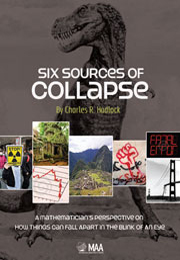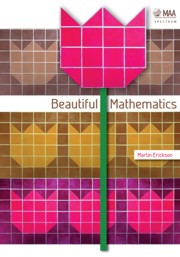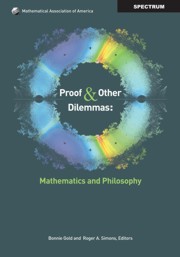23 results in Spectrum

I, Mathematician
-
- Published by:
- Mathematical Association of America
- Published online:
- 09 June 2017
- Print publication:
- 01 April 2015
-
- Book
- Export citation

Half a Century of Pythagoras Magazine
-
- Published by:
- Mathematical Association of America
- Published online:
- 26 May 2017
- Print publication:
- 01 November 2015
-
- Book
- Export citation

How Euler Did Even More
-
- Published by:
- Mathematical Association of America
- Published online:
- 05 December 2015
- Print publication:
- 01 December 2014
-
- Book
- Export citation

Illustrated Special Relativity through its Paradoxes
- A Fusion of Linear Algebra, Graphics, and Reality
-
- Published by:
- Mathematical Association of America
- Published online:
- 05 September 2014
- Print publication:
- 05 September 2014
-
- Book
- Export citation

Non-Euclidean Geometry
-
- Published by:
- Mathematical Association of America
- Published online:
- 05 September 2014
- Print publication:
- 01 June 1998
-
- Book
- Export citation

Mathematical Fallacies, Flaws, and Flimflam
-
- Published by:
- Mathematical Association of America
- Published online:
- 05 December 2013
- Print publication:
- 01 January 2000
-
- Book
- Export citation

More Fallacies, Flaws, and Flimflam
-
- Published by:
- Mathematical Association of America
- Published online:
- 05 December 2013
- Print publication:
- 01 November 2013
-
- Book
- Export citation

Six Sources of Collapse
- A Mathematician's Perspective on How Things Can Fall Apart in the Blink of an Eye
-
- Published by:
- Mathematical Association of America
- Published online:
- 05 April 2013
- Print publication:
- 15 December 2012
-
- Book
- Export citation

In the Dark on the Sunny Side
- A Memoir of an Out-of-Sight Mathematician
-
- Published by:
- Mathematical Association of America
- Published online:
- 05 November 2012
- Print publication:
- 30 September 2012
-
- Book
- Export citation

Sophie's Diary
- A Mathematical Novel
-
- Published by:
- Mathematical Association of America
- Published online:
- 05 June 2012
- Print publication:
- 15 April 2012
-
- Book
- Export citation

Calculus and Its Origins
-
- Published by:
- Mathematical Association of America
- Published online:
- 05 April 2012
- Print publication:
- 15 February 2012
-
- Book
- Export citation

A Mathematician Comes of Age
-
- Published by:
- Mathematical Association of America
- Published online:
- 05 March 2012
- Print publication:
- 15 December 2011
-
- Book
- Export citation

Sherlock Holmes in Babylon
- And Other Tales of Mathematical History
-
- Published by:
- Mathematical Association of America
- Published online:
- 05 January 2012
- Print publication:
- 01 August 2003
-
- Book
- Export citation

Mathematics in Historical Context
-
- Published by:
- Mathematical Association of America
- Published online:
- 05 January 2012
- Print publication:
- 03 January 2011
-
- Book
- Export citation

Mathematical Reminiscences
-
- Published by:
- Mathematical Association of America
- Published online:
- 05 January 2012
- Print publication:
- 30 June 2001
-
- Book
- Export citation

Beautiful Mathematics
-
- Published by:
- Mathematical Association of America
- Published online:
- 05 January 2012
- Print publication:
- 01 December 2011
-
- Book
- Export citation

Harmony of the World
- 75 Years of Mathematics Magazine
-
- Published by:
- Mathematical Association of America
- Published online:
- 05 January 2012
- Print publication:
- 01 June 2007
-
- Book
- Export citation

500 Mathematical Challenges
-
- Published by:
- Mathematical Association of America
- Published online:
- 05 January 2012
- Print publication:
- 01 June 1995
-
- Book
- Export citation

The Words of Mathematics
- An Etymological Dictionary of Mathematical Terms used in English
-
- Published by:
- Mathematical Association of America
- Published online:
- 05 January 2012
- Print publication:
- 01 June 1994
-
- Book
- Export citation

Proof and Other Dilemmas
- Mathematics and Philosophy
-
- Published by:
- Mathematical Association of America
- Published online:
- 05 November 2011
- Print publication:
- 03 January 2008
-
- Book
- Export citation

